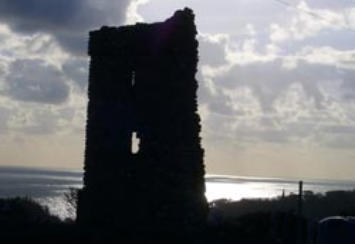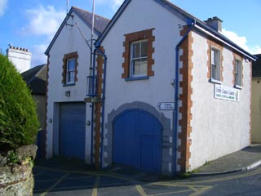





© 2021 www.dunmoreeast.net. All rights reserved Last updated 26 December 2021

The Apparatus

Dunmore East is a small fishing village on
the south-east coast of Ireland, 16kms from
the city of Waterford.
It sits on the western side of the Waterford
Harbour Estuary, 4.8kms from Hook Head in
Wexford.
Dunmore East, Co. Waterford,
Ireland
“The Apparatus”, consisted of an old horse drawn carriage on iron wheels, which was built in the days of sail. The
carriage was fitted out with all kinds of goodies including grass rope, old stepladders, lanterns, and wicker basket
helmets, which looked like something from Roman times. It lay hidden behind the doors (in the attached pic) for
years, and was crewed in its time by some notable Dunmore characters.
The idea behind the apparatus was to provide a coast rescue service
whereby ship wrecked mariners could be hauled ashore by the “apparatus”
crew standing on the cliffs above. The “apparatus” was unique in its day. If a
ship was driven ashore in a gale and the Lifeboat was unable to reach the
stranded crew from the seaside of the incident, it was then time to call “the
apparatus”
A team of horses would pull the carriage through the village to the disaster.
The volunteer crew would unload their wooden rope filled boxes high on the
cliff above the wreck or on a long sandy beach. They had a very powerful
rocket attached to a rope which could be shot over and beyond the stranded vessel. The crew of the vessel would
then tie the rope on to the mast of the ship. The “apparatus” crew would then winch a “breeches boy”, basically a
swimming tube with a pair of pants attached to it, out to the ship, and one by one the ships crew would enter the tube
to be winched to safety by the “ apparatus” crew standing on the cliff or strand.
Yes, the wonders of modern technology in 1874, but I joined the apparatus in 1974 and things were slightly different.
Firstly, the glamour had gone from the job. Who cared about the auld “apparatus” ? All the glamour was attached to
the Lifeboat, everyone wanted to crew the Lifeboat, Yuppies, Farmers, Emmets, Shopkeepers, Townies, but no one
wanted to ride through the streets of Dunmore sitting high on an Irish version of a Wild West stagecoach being pulled
by Enda Flynn's Tractor.
God the mortification of it, clanging and banging along the dock road, a couple of aulfellas sitting up front as the
senior Men, and the rest of us long haired youngfellas sitting at the back. Young Aiden Flynn in a new seriously
powerful tractor pulling the be Jesus out of the “apparatus” wagon, getting it to speeds that horses only dreamt
about. Youngfellas giving us the finger and “stop the lights” if a young wan that you were interested in saw you on top
of the spectacle, yer chances with her were ruined forever.
To make matters worse some fool had invented Helicopters, which had the uncanny ability to winch injured persons
to safety from stricken vessels. Not to be outdone we always continued to the scene where we would stand and
watch the flash Lifeboat or the Helicopter completing the rescue. “Back to the shed boys” would come the order from
our No 1 Man, (just in case anybody missed us going through the village the first time), and “we were here if we were
needed” was the usual consolation.
I joined in 1974 because me Aulfella was the number 2 Man and he press-ganged me into volunteering my services.
Willie Dunne was the No 1 Man, and Billy Hearn “The Saint” was number 3. We had another few aulfellas and
youngfellas from the village to make up the crew. The youngfellas joined because every three months on practice
days we received one pound and seventy five pence which we promptly drank in the Butchers Pub immediately after
payment. The money was paid to us out of a suitcase by a Mr Jeffers. He was an old ex-Navy Man who had the job
of travelling around the different stations to ensure that all “apparatus” crews were trained up to speed. Times were
hard in 1974. Dunmore was not as wealthy as it is today and any auld pound was welcome.
There was one episode that stands out in my memory. We were forever holding mock training sessions up on
Shanoon where everything was simulated including the firing of our rocket. One day in the spring of 1975, Mr Jeffers
announced to us that we would actually fire the rocket on his next visit. Upon hearing this news all of the younger
fellas were delighted, we would show the flash lifeboat guys what a rocket should sound like (it was reported that the
“apparatus” rocket was 10 times louder than the rocket used to summon the lifeboat crew during an emergency)
The day finally dawned and we left the station and made the trip to Shanoon on our wagon, once again the source of
bemusement to all who saw us pass by. “Never mind” we thought, “within the next hour ye will be so deaf from our
rocket that ye will hold us in high esteem for the rest of ye'er lives” We reached Shanoon and unloaded our boxes,
ropes, rocket, rocket launcher and tripod. The rope for the rocket was contained in two coffin-like green boxes. It was
intertwined around pegs that were sunken in to the bottoms of the boxes. The sides of the boxes could be removed
when firing the rocket and the rope, attached to the rocket, would automatically unwind from the box as the rocket
sped into the sky.
We were getting ready to fire. We had already dispatched a Man to warn The Convent Nuns and other villagers that
what they were about to hear was not the beginning of world war three but simply the “apparatus” on manoeuvres.
We had our rocket in its launch pad, we had it connected to a rope leading from one of our green boxes, we were all
ready, so the launch sequence began as follows.
11 am . “Over to you now Number 1”, said Mr Jeffers.
11.01 . “Stand behind me now Men”, said Number 1 “and put ye'er hands over ye'er ears.
11.03 . “In Pigtail, Number 2” said Number 1 ( the pigtail being a type of electric plug that was attached to the rocket
and also to a battery that was hanging from Number 1's neck).
11.04 . “Ready Men” says Number one .
11.04. "Yes", came the response.
11.05 BANG !!
It was the loudest explosion I have ever heard. Shanoon shook, seagulls left Creaden Head never to be seen again,
slates flew off the convent. The Nuns all dived for cover beneath tables and anything else they could find. We
couldn't see a thing for a few seconds because of the smoke, and we didn't hear again for three days. When we
looked up we could see our rocket streaking through the sky carrying some strange object in its wake, it entered the
sea about a quarter of a mile off Shanoon at a speed of around 900 miles an hour almost removing the bow of a
salmon punt which was steaming ashore to Dunmore harbour. The crew probably did not hear the explosion on
account of the noise from their outboard motor.
A hushed silence fell upon us when we realised the strange object behind our rocket was nothing more than one of
our coffin-like boxes. In our haste, we had forgotten to remove its sides and consequently it had been launched into
the Celtic Sea never to be seen again.
Number 1 was devastated, Number 2 lit a Woodbine, and Mr Jeffers lit a Players.
“Be God,” we heard Mr Jeffers say, “we launched our box full of rope Men, not the thing to do when we have a ship
on the shore. I will have to order a new one from Courtmacsherry”. We then returned to camp and ended up in the
Butchers analysing our misfortune.
In another Bar in the village, the crew of a salmon punt were attempting to persuade a sceptical gathering that they
had witnessed the strangest burial that anyone had ever seen. They reportedly told a group of Men that when they
were steaming ashore about an hour earlier someone had launched a coffin into the sea not far from Black Knob,
and about a quarter of a mile from shore. The coffin had hit the water at a tremendous velocity, near cutting the bow
off their punt. They believed it hit the water so fast it could only have come from a passing aircraft.
The truth would eventually be revealed.
Ringo Regan, December/2005



















